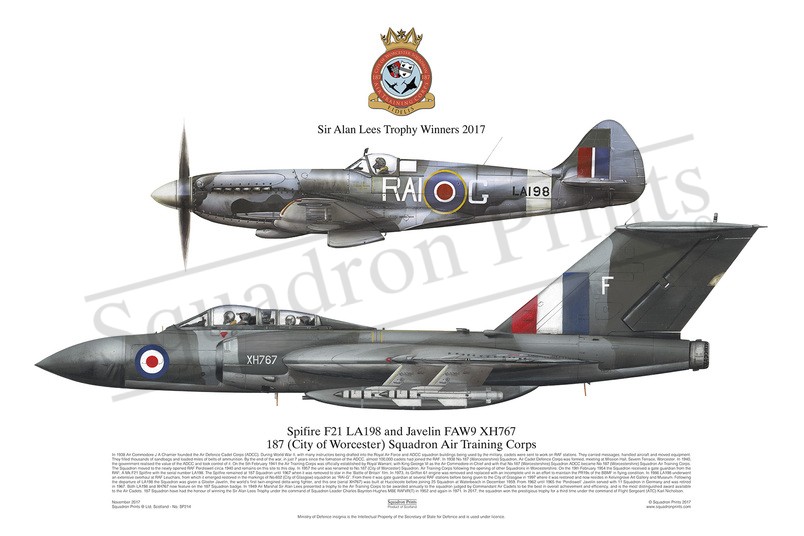#SP214 Spitfire F21, Javelin FAW9

Purchased products will not feature the Squadron Prints watermark
Description
Squadron Prints Lithograph No. SP214 - Spitfire F21 LA198 and Javelin FAW9 XH767, 187 (City of Worcester) Squadron Air Training Corps.
In 1938 Air Commodore J A Chamier founded the Air Defence Cadet Corps (ADCC). During World War II, with many instructors being drafted into the Royal Air Force and ADCC squadron buildings being used by the military, cadets were sent to work on RAF stations. They carried messages, handled aircraft and moved equipment. They filled thousands of sandbags and loaded miles of belts of ammunition. By the end of the war, in just 7 years since the formation of the ADCC, almost 100,000 cadets had joined the RAF. In 1938 No.187 (Worcestershire) Squadron, Air Cadet Defence Corps was formed, meeting at Mission Hall, Severn Terrace, Worcester. In 1940, the government realised the value of the ADCC and took control of it. On the 5th February 1941 the Air Training Corps was officially established by Royal Warrant, with King George VI as the Air Commodore-in-Chief and with that No.187 (Worcestershire) Squadron ADCC became No.187 (Worcestershire) Squadron Air Training Corps. The Squadron moved to the newly opened RAF Perdiswell circa 1940 and remains on this site to this day. In 1957 the unit was renamed to No.187 (City of Worcester) Squadron, Air Training Corps following the opening of other Squadrons in Worcestershire. On the 19th February 1954 the Squadron received a gate guardian from the RAF; A Mk.F21 Spitfire with the serial number LA198. The Spitfire remained at 187 Squadron until 1967 when it was removed to star in the 'Battle of Britain' film. In 1973, its Griffon 61 engine was removed and replaced with an incomplete unit in an effort to maintain the PR19s of the BBMF in flying condition. In 1986 LA198 underwent an extensive overhaul at RAF Leuchars, from which it emerged restored in the markings of No.602 (City of Glasgow) squadron as "RAI-G". From there it was gate guardian at several RAF stations before being given to the City of Glasgow in 1997 where it was restored and now resides in Kelvingrove Art Gallery and Museum. Following the departure of LA198 the Squadron was given a Gloster Javelin, the world’s first twin-engined delta-wing fighter, and this one (serial XH767) was built at Hucclecote before joining 25 Squadron at Waterbeach in December 1959. From 1962 until 1965 the 'Perdiswell' Javelin served with 11 Squadron in Germany and was retired in 1967. Both LA198 and XH767 now feature on the 187 Squadron badge. In 1949 Air Marshal Sir Alan Lees presented a trophy to the Air Training Corps to be awarded annually to the squadron judged by Commandant Air Cadets to be the best in overall achievement and efficiency, and is the most distinguished award available to the Air Cadets. 187 Squadron have had the honour of winning the Sir Alan Lees Trophy under the command of Squadron Leader Charles Baynton-Hughes MBE RAFVR(T) in 1952 and again in 1971. In 2017, the squadron won the prestigious trophy for a third time under the command of Flight Sergeant (ATC) Karl Nicholson.
You may also like
-
Tornado GR4A
ZG707 'B'617 Sqn; 13 Sqn; 31 Sqn; 2 Sqn; Combat Air Wing; 9 SqnAli Al Salem, Kuwait -
SALE RIAT 2018 Print Juno, Phenom, Sentinel, Atlas, F-35 Lightning
ZJ692; ZM334; ZM505; ZM416; ZM148RIAT 2018RAF Fairford -
Meteor, Hunter, Phantom, Tornado F3
XV579 'R'; XF515 'R'; ZE887 'GF'; XV571 'A'; ZE961 'GA'; WA756 'F'; WA794; WT597 'C'43 SqnRAF Leuchars
